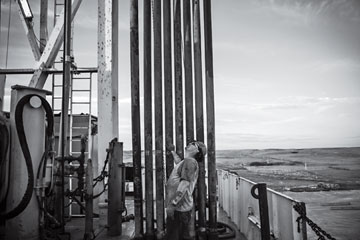
Fracking has unlocked new oil supplies in states like North Dakota, reducing crude imports.
(2 of 6)
Success could be even scarier: if new technologies can ensure that fossil fuels remain relatively cheap for decades ahead, it will be that much more difficult to wean the world off carbon in time to avert dangerous climate change. Global carbon emissions hit an all-time high last year, and the International Energy Agency reported in June that the world was on a path toward temperature increases that could be as high as 9.5°F by the end of the century. "People can no longer rely on high oil prices and fossil-fuel scarcity to motivate a climate agenda," says Amy Myers Jaffe, executive director of energy and sustainability at the University of California at Davis. "It completely changes the picture." The American energy revolution is real--but it may be too much of a good thing.
From Bust to Boom
Here are some telling numbers: in 2004 the Energy Department's bean counters projected that the U.S. would be importing 2.5 trillion cu. ft. of liquefied natural gas (LNG) by 2011, with the expectation that the figure could grow to nearly 5 trillion by 2025. LNG terminals were constructed in East Coast cities to process expected imports of gas from the Middle East to make up for dwindling domestic methane production. The oil picture was worse: in 2005 the U.S. was importing 12.5 million barrels a day, a figure the Energy Department projected would grow to more than 15 million by 2025. "It seemed like we were stuck in an age of limitations," says Michael Lynch, director of global petroleum at the consultancy Strategic Energy & Economic Research.
Scarcity seemed to be written into the rocks--and then the writing changed. Geologists had known for decades that shale found thousands of feet below the earth's surface contained vast quantities of oil and gas. For decades, though, that didn't matter. Oil and gas that are too difficult and too expensive to get out of the ground are of no use to anyone. Two innovations--both invented in the U.S.--changed all that. By drilling down into the shale and then horizontally through the rock layer while pumping millions of gallons of water laced with chemicals at high pressure to fracture the rock, energy companies could economically unlock the oil and gas found in the shale. The oil and gas industry had been fracking wells for decades, but the process was taken to a new level by the maverick energy entrepreneur George Mitchell, who hit pay dirt in 1998 when he substituted water for more expensive drilling fluids while fracking Texas' Barnett Shale, west of Fort Worth. Washington helped as well: Mitchell and other fracking entrepreneurs benefited from federal research and a 1980 tax credit that supported drilling for unconventional gas.
